how big's your neighbourhood?
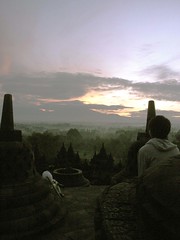
watching the sunrise at Burobudor
The islands that make up the Indonesian republic are only an hour or so away from ours by air. But other than a trip to Bali some 10 years ago, I've not been to this part of our ASEAN neighbourhood until the trip last week.
The 5 days to Yogyakarta and Jakarta were taken up mostly by visits to artist studios, galleries and (very wealthy!) art collectors' homes. It was a cloistered view into this vast nation. But even so, the very narrow glimpse afforded by the art and the very few folks I met already suggested the complexity and wealth of the social and cultural resource and challenges of the world's 4th largest population. The trip and various conversations were short, but difficult to summarise. So instead of trying to make something coherent of it, here's a photo-diary (and some links):
Jogja Community DIY:
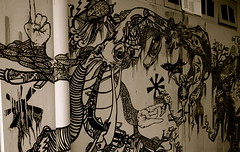
wall art on the IVAA courtesy of Jogjakarta's resident street artist "LoveHateLove"
The Indonesian Visual Art Archive is a 2-year old organisation. It is housed in an old, modest 1 storey house comprising a library of art books, a small canteen, a 3x5m gallery space and, its main business, a treasure trove of interviews, event videos and articles about Indonesian art. The staff are in the process of digitising the material. Other than some "guilt money" funding from Netherlands and "goodwill" money from the Asia-Europe Foundation, the centre runs on a small revenue from library subscriptions. No Indonesian state funding. The walls, shelves and chairs show their age. But the folks who run it are far from run down!

Independent Curator Enin introducing Jumaldi Alfi at the Kelompok Jendela
The latest artist-run residency space by Kelompol Jendela similarly receives no state funding. A beautifully designed 2 storey building in concrete, timber, exposed concrete and stone, it was supposedly started following a conversation between independent curator Enin and 30-something artist Alfi when the former asked the latter what he could do to "give back" to the Jogja art community now that he was financially stable. Admirable!
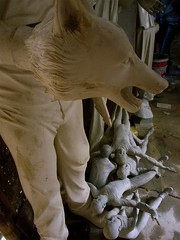
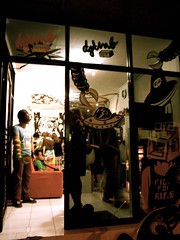
different ways of masking - (L)plaster model at Agus Suwage's studio, (R) the dgtmb shop set up by a group of comic/street artists
Collectors nationale:

Prominent collector Dr Oei Hong Djien's contemporary art collection
Maybe it's just the pragmatic reason that the economic value of Indonesian art makes for a better investment, but almost every collector - young, old, educated, informed, passionate or just plain rich - has a singular interest in Indonesian art. When asked why, their reply would usually amount to "because I'm Indonesian". Their more altruistic elaborations include supporting young Indonesian artists ("so many of them don't even have money for food!"), collecting a part of the nation's history, or just being able to appreciate and understand the context and culture from which the art arose. One impassioned collector organises regular art education seminars and discussions for young collectors and issues 1000 sms-es each week on art events.
But the strong influence of the market is starting to show its negative impact. For sure, many of the collectors are also hard-nosed investors (a couple have moved on to be art dealers). Except for 1st president Sukarno's art collection, the best of Indonesia's art is now in private hands. While collectors like Dr Oei Hong Djien (a member of the Singapore Art Museum board!) have opened up his comprehensive collection to the public by erecting 2 gallery buildings in his private compound in Magelang, most remain hidden from public view. In a way, the situation reflects the glaring chasm between the wealthy and the poor in Indonesia.
Another Biennale?:

installation Zacht by Iswanto Hartono
The divide is obvious in the city's high-end shopping malls, which are quiet save for the visits by the chaffeured class. It is therefore telling that two of the latest shopping malls, Seneyan City and Grand Indonesia, are hosting a segment of the Jarkarta Biennale.
Organised by the Jakarta Arts Council, this is the first time the Jakarta Biennale includes international artists. The opening was mostly attended by the art student crowd, and the work at the National Art Gallery was patchy. Still, there were some gems. Indonesian artist Jompet's installation of phantom soldiers harking back to the period of Dutch colonialisation was especially powerful, their programmed drum beats reverberate menacingly in the basement of the Gallery. Many of the works explore Indonesia and, indeed, the region's colonial past, and the possibility of cultural dialogue against the contemporary narrative of economic and cultural globalisation.
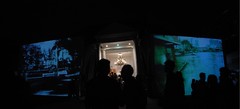
On opening night, video projections on the Gallery's facade. One is a footage of modern Indonesian streets, one B/W footage of the past. One of Mozart's piano concerto (I think) plays in the background.
A writer expressed to me her optimism about the Jakarta Biennale's development towards greater regional representation and exchange, in particular the ASEAN region since the world at large were sufficiently engaged with East and South Asia culture. A collector expressed his skepticism that such regional optimism had existed in the 60s and was not new (i.e. would not take off). For me, the trip and conversations made real of art's dynamic and tension-filled relationship with society, state and the individual; its use for change and to celebrate/cement the status quo. It probably wouldn't be too harsh to say that the art I saw in those few days was immaterial to the average Indonesian's quality of life, yet it seemed absolutely integral to the identity and vitality of the collective body. It also made me even more conscious of how much there is to learn about the countries - their history, culture and society - around our little island.
======
p/s Keen to see Indonesian art in Singapore?
(1) Work by artists from the Jendela Group would be exhibited at the NUS Museum from 27 Feb till Apr09. For more information, see here
(2) Indonesian artist Agus Suwage just completed a residency stint at the Singapore Tyler Print Institue (see here), so his works should be on show at the STPI sometime this year.
(3) Dr Oei Hong Djien's collection is documented in a book Exploring Modern Indonesian Art, available at Select Book store. 35 works from his collection are also on long-term loan to SMU and can be viewed at the campus, see here.



Comments